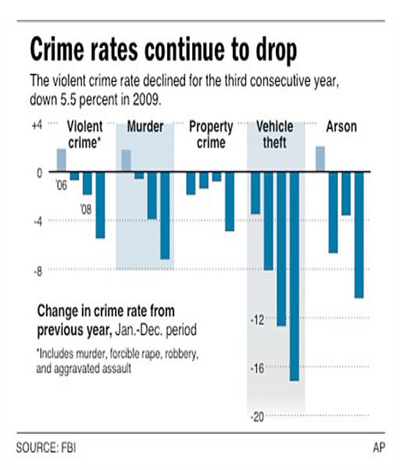Crime in the United States dropped dramatically in 2009, bucking a historical trend that links rising crime rates to economic woes. Property crimes and violent offenses each declined about 5 percent, the FBI said Monday, citing reports from law enforcement coast to coast.

Graphic shows preliminary data for changes in crime rates. (D. Morris, AP / May 24, 2010)
It was the third straight year of declines, and this year's drops were even steeper than those of 2007 and 2008, despite the recession.
There were words of caution from experts.
"It's fabulous news, but I would draw an analogy to global warming: Even if you believe the long-term trend is increasing temperatures, it doesn't mean you can't have a cold year," said Jonathan P. Caulkins, a professor of public policy at Carnegie Mellon University's Heinz College.
Last year's decline was 5.5 percent for violent crime, including 7.2 percent for murders. The rate for property crime was down 4.9 percent, the seventh consecutive drop for that category. The declines had been a more modest 1.9 percent for violent crime and 0.8 percent for property crime in 2008 and 0.7 percent and 1.4 percent respectively the previous year.
Long term, said Northeastern University criminology professor James Alan Fox, "there is a connection between an economic downturn and crime: Budget cuts create significant challenges in keeping crime rates low. We have increasing numbers of at-risk youth in the population, and they need services. We need to reinvest in crime prevention or else the good news we see today could evaporate."
The nation's jobless rate hit 10.2 percent last October, reaching double digits for the first time in 26 years. The rate was 9.9 percent last month.
"We thought our property crimes during a recession would probably go up," said Sgt. Trent Crump, a police department spokesman in Phoenix, where property crime declined more than 20 percent. Homicides in Phoenix were down over 25 percent. Crump attributed the drop in crime to a department focus on getting more officers on the street, targeting repeat offenders and forming partnerships with community leaders.
Experts offered a range of factors that might have contributed to the drop in reported crimes.
In the past, increases during economic downturns have tended to correspond to street level drug activity. One example is the crack cocaine epidemic during the economic decline of the late 1980s and early 1990s, said Richard Rosenfeld, professor of criminology at the University of Missouri in St. Louis.
Currently, "we're not seeing - at least as yet - comparable increases in drug market activity," said Rosenfeld.
Factors "that often contribute to violence don't seem to be there," said Professor Alfred Blumstein of the Carnegie Mellon Heinz School, whose research over the past 20 years has covered many aspects of the criminal justice system. Blumstein said there's a consistency in the latest data "that you usually don't see." He said of 22 of the largest cities, homicides were down in 18 and up in four. The consistency continued into the category of robbery, which went down in 20 of the biggest cities and up in two.
Fox said the criminal justice system has done a good job of dealing with violence among at-risk youth, and police departments have better technology and other ways to gather information so law enforcement resources are used more effectively to investigate crime and apprehend offenders.
"There are a lot of tools that are keeping cops two steps ahead of the crooks," said Fox.
Washington, D.C., Assistant Police Chief Peter Newsham said the presence of video surveillance cameras and other technology has made it "a lot more difficult to get away with" property crime.
The FBI collected the crime data from more than 13,000 law enforcement agencies around the country.
According to the numbers, all four measured categories of violent crime declined compared with 2008 - robbery, murder, aggravated assault and forcible rape.
Violent crime declined 4 percent in metropolitan counties and 3 percent elsewhere, the FBI reported.
Nationwide, the murder rate was down 7.2 percent last year.
The largest decrease in murders - 7.5 percent - took place in cities of half a million to a million in population. The only increase - 5.3 percent - occurred in cities with 25,000 to 50,000 people.
Robbery dropped 8.1 percent, aggravated assault declined 4.2 percent and forcible rape was down 3.1 percent.
Violent crime fell 6.6 percent in the South, 5.6 percent in the West, 4.6 percent in the Midwest and 3.5 percent in the Northeast.
In Washington, where the number of murders fell from 186 to 143, Phil Mendelson, chairman of the D.C. Council's public safety committee, said case closure rates have gone up as detectives work more quickly and information is shared more within the department.
The police department in Columbus, Ohio, where the violent crime rate went down 10 percent, has been trying different neighborhood strategies, including direct patrols of precinct hot spots aimed at reducing thefts and prostitution. Sgt. Rich Weiner said it is difficult to quantify the role the economy plays in crime rates. Voters last summer approved a city income tax increase that saved 300 police jobs, Weiner said. The city got $1.25 million in federal stimulus money last year to pay the salaries of about 25 new police recruits.
The preliminary numbers will be updated later this year.











